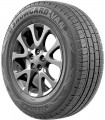Season
The time of the year the tyres are designed for.
Tyres designed for the warm season are called
summer, for cold — respectively, winter (among the latter,
studded and
non-studded models are separated, see below for details). The need for separation by season is due to the fact that when the temperature drops, the rubber solidifies; therefore, cold weather requires softer tyres than warm weather. And the time when you need to change tyres is best determined by the average daily temperature: if it is above +5 °C, it is better to use summer tyres, if lower — winter ones. There are also more detailed recommendations regarding the time of changing tyres, they can be found in special sources.
Also note that there are tyres positioned as
all-weather. Such models should be treated with some caution: they can be produced in countries where winters are very mild, without snow and severe frosts, and be designed specifically for such “all-season”; for a full-mean winter, such tyres may not be suitable. So the specific attributes of all-season tyres should be specified separately (including reviews). If there are no detailed info, such tyres are best considered as summer tyres with slightly increased resistance to cold, and if used in winter, then in simple conditions (for example, driving along well-cleaned city streets).
Load index
The maximum weight load that the tyre is able to carry. It is denoted by a conditional figure, each of which corresponds to a certain value:
66 - 300 kg, 67 - 307 kg, 68 - 315 kg, 69 - 325 kg, 70 - 335 kg, 71 - 345 kg, 72 - 355 kg, 73 - 365 kg, 74 - 375 kg, 75 - 387 kg, 76 - 400 kg, 77 - 412 kg, 78 - 425 kg, 79 - 437 kg, 80 - 450 kg, 81 - 462 kg, 82 - 475 kg, 83 - 487 kg, 84 - 500 kg, 85 - 515 kg, 86 - 530 kg, 87 - 545 kg, 88 - 560 kg, 89 - 580 kg, 90 - 600 kg, 91 - 615 kg, 92 - 630 kg, 93 - 650 kg, 94 - 670 kg, 95 - 690 kg, 96 - 710 kg, 97 - 730 kg, 98 - 750 kg, 99 - 775 kg, 100 - 800 kg, 101 - 825 kg, 102 - 850 kg, 103 - 875 kg, 104 - 900 kg, 105 - 925 kg, 106 - 950 kg, 107 - 975 kg, 108 - 1000 kg, 109 - 1030 kg, 110 - 1060 kg, 111 - 1090 kg, 112 - 1120 kg, 113 - 1150 kg, 114 - 1180 kg, 115 - 1215 kg, 116 - 1250 kg, 117 - 1285 kg, 118 - 1320 kg, 119 - 1360 kg, 120 - 1400 kg, 121 - 1450 kg, 122 - 1500 kg, 123 - 1550 kg, 124 - 1600 kg, 125 - 1650 kg, 126 - 1700 kg, 127 - 1750 kg, 128 - 1800 kg, 129 - 1850 kg, 130 - 1900 kg, 131 - 1950 kg, 133 - 2060 kg.
While choosing according to this indicator, it is worth considering not only the maximum weight of the car for which tyres are going to buy, but also the distribution of weight along the axles. With passenger cars, everything is simple — the weight is distributed approximately equally, so to determine the load on each wheel, it is enough to divide the maximum mass of the car by 4 (the number of wheels). H...owever, in minibuses, light trucks and SUVs, the situation is different: the weight distribution can be unequal, so you should refer to the manufacturer's documents or other special sources to calculate the load on each wheel.
Anyway, the load index must not be exceeded — this creates the danger of an accident. In fact, the wheel load should be at least 10 – 15% below the maximum, this will give an additional guarantee in case of abnormal loads. Also note that in some high-speed tyres, with the speed maximum approaching, the permissible load decreases: for example, for tyres with the V index (see "Speed rating") with speed over 210 km/h, it is recommended to reduce the load by 3% for every next 10 km/h increase in speed, similar recommendations apply to models with indexes W and Y. These details are usually described in the manufacturer's documentation and other special sources.
Fuel efficiency
The rolling resistance rating that the tyre corresponds to. The higher this figure, the lower the resistance, the less fuel is spent to overcome it and the more economical the tyre is. Efficiency indices are denoted by letters of the Latin alphabet in descending order of efficiency:
A(highest efficiency),
B,
C,
D,
E,
F,
G(lowest efficiency).
With other things being equal, more economical tyres tend to cost more, but the difference is offset by fuel economy.
Wet Grip
An index that determines the overall performance of a tyre on wet pavement. Lettered from
A(highest) to
G(lowest); intermediate options, respectively —
B,
C,
D,
E and
F.
The higher this indicator, the stronger the tyre grips to the wet road, the more efficient and safer it will be in difficult weather conditions. At the same time, it is worth noting that a low grip index does not mean unsuitability for driving in rain or snow — you just need to be more careful using such tyres. Conversely, a high index does not relieve the driver of the need to be careful in difficult weather conditions.
Noise Level
The average noise level created by a tyre while driving. The lower this indicator, the more comfortable this model will be, the less additional noise it will create.
Note that EU rules provide 3 categories of tyres in terms of noise.
“Quiet” are considered models with an index of up to 68 dB,
“medium” — 68 – 71 dB,
“loud” — 72 dB and above.

